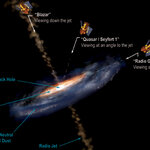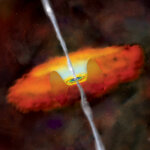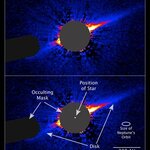Space

Stars don’t shine forever. How long a star lives depends on how big and heavy it is. The bigger the star, the shorter its life.
When a star significantly heavier than our sun runs out of fuel, it collapses and blows itself apart in a catastrophic supernova explosion. A supernova releases so much light that it can outshine a whole galaxy of stars put together. The exploding star sweeps out a huge bubble in its surroundings, fringed with actual stellar debris along with material swept up by the blast wave. This glowing, brightly-coloured shell of gas forms a nebula that astronomers call a ‘…

You’d think that astronomers would have found all the different classes of active galaxy nuclieu (AGN ) - after all, AGN such as quasars, blazars, and Seyfert galaxies are among the most luminous objects in our Universe, pouring out the energy of billions of stars from a region no larger than our solar system.
But a team has discovered that a relatively common class of AGN has escaped detection until now. These objects are so heavily shrouded in gas and dust that virtually no light gets out.
"This is an important discovery because it will help us better understand why some supermassive black…

‘Killer’ electrons are highly energetic, negatively charged particles found in near-Earth space. They can critically, and even permanently, damage satellites in orbit, including telecommunication satellites, and pose a hazard to astronauts.
Several theories have been formulated in the past to explain the origin of killer electrons, and many uncoordinated observations have already been performed. Recently, scientists got a boost in their understanding of this hazardous phenomenon. This was possible thanks to a unique set of data, collected simultaneously, by a global armada of ground and space…

In just over a week's time NASA's Phoenix Lander is due to launch for Mars where it will probe the arctic landscape searching for conditions favourable for past or present life. UK scientists from Imperial College London and the University of Bristol have provided hardware and are involved in the science operations.
The launch is scheduled for 1035 am GMT (0535 am EDT) on 3rd August (3 week launch window) with the spacecraft starting its journey onboard a Delta II rocket from Cape Canaveral, Florida. Phoenix will descend and land on the Red Planet's northern plains, in the area known as…

Supermassive black holes have been discovered to grow more rapidly in young galaxy clusters, according to new results from NASA's Chandra X-ray Observatory. These "fast-track" supermassive black holes can have a big influence on the galaxies and clusters that they live in.
Using Chandra, scientists surveyed a sample of clusters and counted the fraction of galaxies with rapidly growing supermassive black holes, known as active galactic nuclei (or AGN). The data show, for the first time, that younger, more distant galaxy clusters contained far more AGN than older, nearby ones.
Galaxy clusters…

Astronomers have found a debris disk around HD 15115. As seen from Earth, the edge-on disk resembles a needle sticking out from the star.
Astronomers think the disk's odd imbalanced look is caused by dust following a highly elliptical orbit about the star. The lopsided disk may have been caused by the gravity of planets sweeping up debris in the disk or by the gravity of a nearby star.
The observations were made by Paul Kalas, James Graham, and Michael P. Fitzgerald, all from the University of California at Berkeley.
The disk, seen edge-on, is the dense blue line extending from the star to…

Frigid geysers spewing material up through cracks in the crust of Pluto’s companion Charon and recoating parts of its surface in ice crystals could be making this distant world into the equivalent of an outer solar system ice machine.
Evidence for these ice deposits comes from high-resolution spectra obtained using the Gemini Observatory’s Adaptive Optics system, ALTAIR coupled with the near-infrared instrument NIRI. The observations, made with the Frederick C. Gillett Gemini North telescope on Hawaii’s Mauna Kea, show the fingerprints of ammonia hydrates and water crystals spread in patches…

The orbiting X-ray telescopes XXM-Newton and Chandra have caught a pair of galaxy clusters merging into a giant cluster. The discovery adds to existing evidence that galaxy clusters can collide faster than previously thought.
When individual galaxies collide and spiral into one another, they discard trails of hot gas that stretch across space, providing signposts to the mayhem. Recognising the signs of collisions between whole clusters of galaxies, however, is not as easy.
When individual galaxies collide and spiral into one another, they discard trails of hot gas that stretch across space,…

ESA’s Venus Express and NASA’s MESSENGER looked at Venus in tandem for a few hours in June. Here is the first set of images.
The orbital geometry of Venus Express when MESSENGER skimmed past Venus on 5 June meant that the two spacecraft were not at the same location (with respect to the surface of the planet) at the exact same time. So how could they make true joint observations of the same regions and phenomena? Scientists came up with a highly creative solution.
Bye-bye Venus. As NASA’s MESSENGER departed from planet Venus on 5 June 2007 to continue its journey towards Mercury, its Wide…
A unique set of observations, obtained with ESO's VLT, has allowed astronomers to find direct evidence for the material that surrounded a star before it exploded as a Type Ia supernova. This strongly supports the scenario in which the explosion occurred in a system where a white dwarf is fed by a red giant.
Because Type Ia supernovae are extremely luminous and quite similar to one another, these exploding events have been used extensively as cosmological reference beacons to trace the expansion of the Universe.
Left: artist's impression of the favoured configuration for the progenitor system…